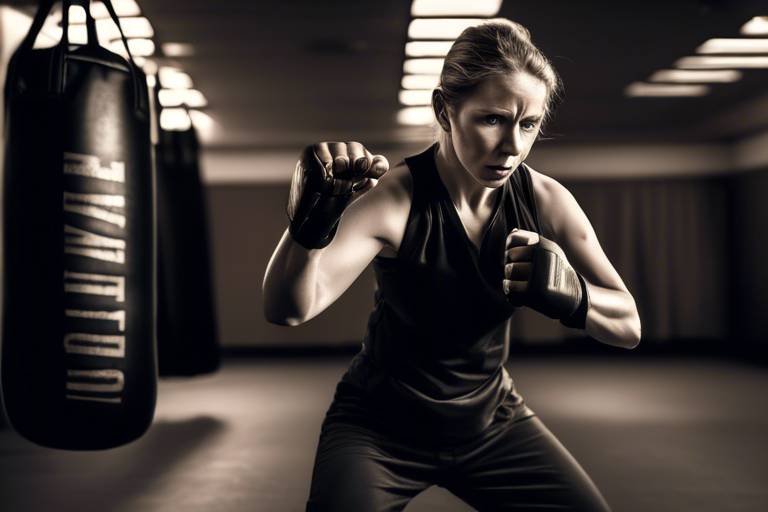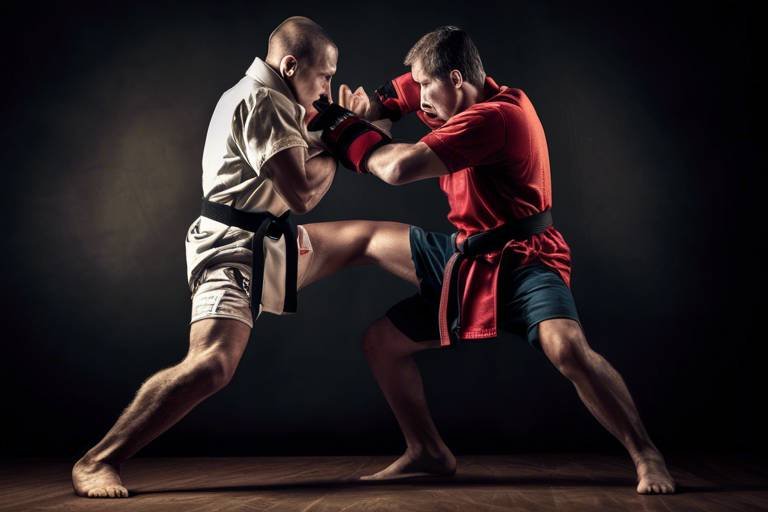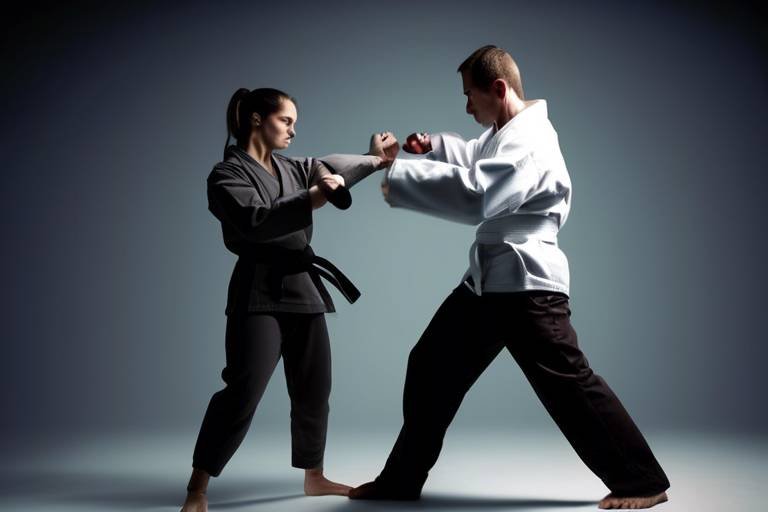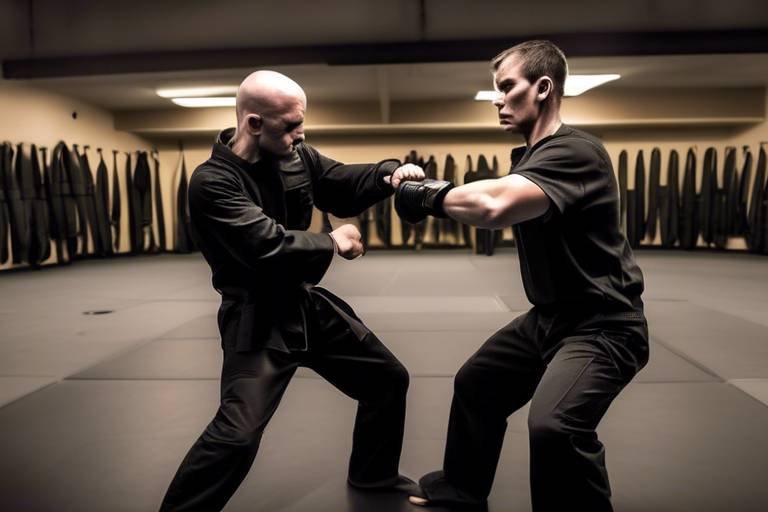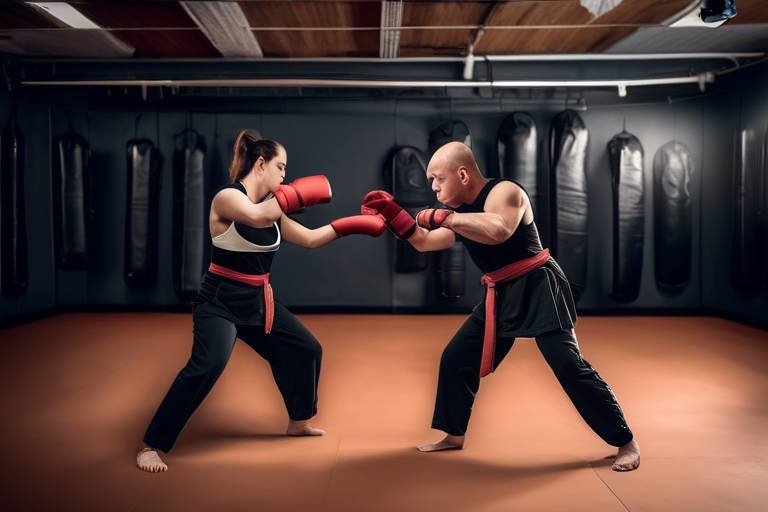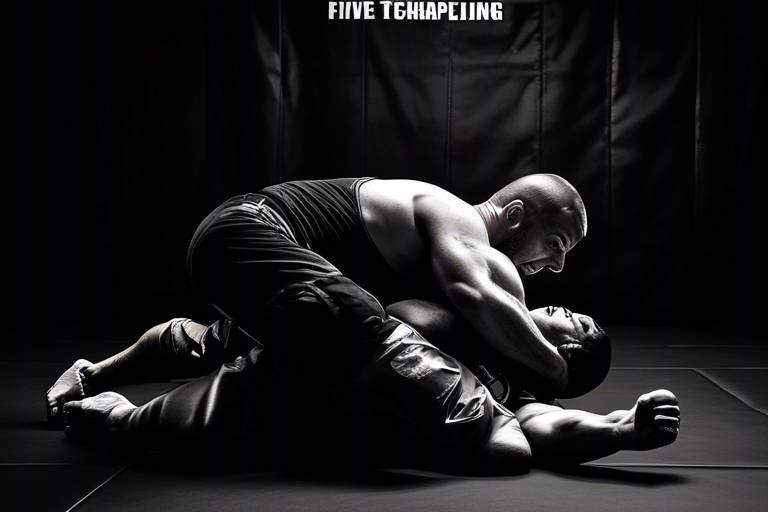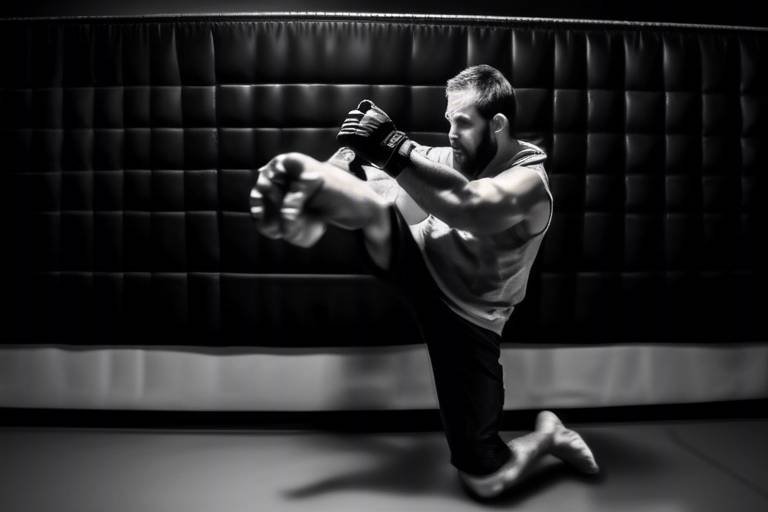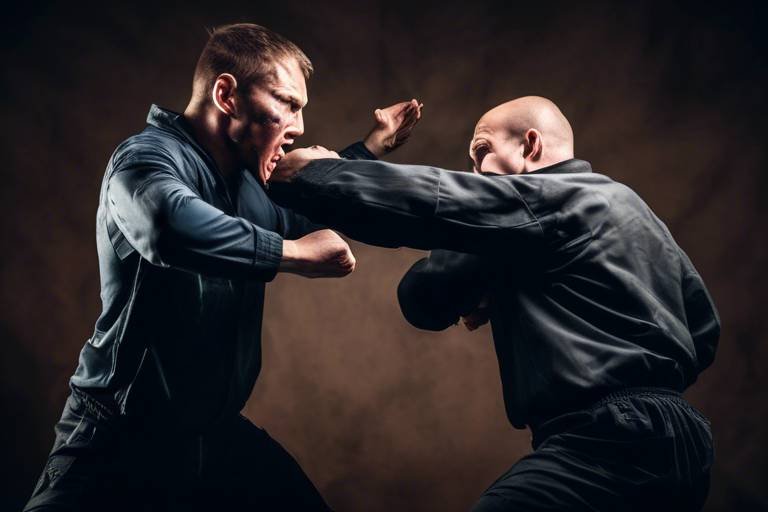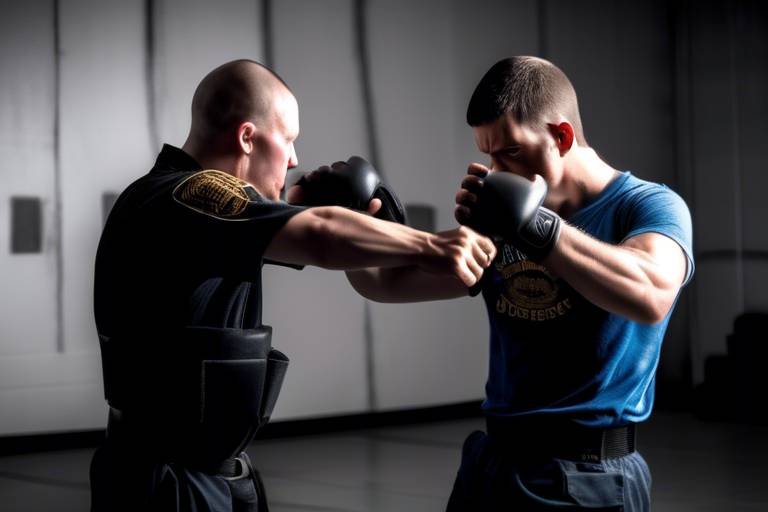Five Ways to Enhance Your Self-Defense Training Regimen
This article explores effective strategies to improve your self-defense training, ensuring you are better prepared for real-world situations while boosting your confidence and skills. Self-defense isn't just about knowing a few moves; it's about developing a comprehensive approach that encompasses physical, mental, and situational elements. By enhancing your training regimen, you can equip yourself with the tools necessary to handle unexpected encounters with poise and effectiveness. Let's dive into five key strategies that can elevate your self-defense skills and mindset.
Cardiovascular fitness is essential for self-defense. Imagine being in a high-stress situation where your heart is racing, and your body is screaming for oxygen. This is where a solid cardio routine comes into play. Engaging in activities like running, cycling, or swimming can significantly enhance your endurance, allowing you to respond more effectively when it counts. Not only does cardio improve your physical stamina, but it also sharpens your mental focus, which is crucial during confrontations. Consider incorporating the following exercises into your regimen:
- Running or Jogging: Great for building stamina and cardiovascular health.
- Interval Training: Short bursts of high-intensity exercise followed by rest can simulate the stress of a self-defense scenario.
- Jump Rope: A fun way to improve coordination and endurance simultaneously.
Situational awareness is crucial for avoiding confrontations. It’s like having a sixth sense that alerts you to potential dangers before they escalate. By honing your ability to observe your surroundings, you can identify threats early and take action to avoid them. Techniques such as scanning your environment regularly and paying attention to body language can significantly enhance your awareness. Here are some methods to sharpen your situational awareness:
Mindfulness can significantly improve your situational awareness. Think of it as training your brain to be present in the moment. Techniques like meditation and breathing exercises can enhance your focus and alertness in daily life. By practicing mindfulness, you train your mind to notice subtle changes in your environment, which can be the difference between safety and danger.
Visualization can prepare you mentally for potential encounters. Picture yourself in various self-defense scenarios; this mental rehearsal can boost your confidence and readiness. By vividly imagining how you would react in different situations, you create a mental blueprint that can guide your actions when faced with real-life threats.
Engaging in daily observation exercises can train your mind to notice details. Challenge yourself to observe your surroundings during mundane activities, like walking to work or waiting in line. Ask yourself questions like, “Who is around me?” or “What is out of place?” This practice can significantly enhance your observational skills and make you more aware of potential threats.
Sparring is vital for applying techniques in real-time. It's like a dress rehearsal for the big show; you get to practice your moves under pressure. Regular sparring helps improve your reflexes, timing, and adaptability in self-defense situations. It’s not just about throwing punches; it’s about learning how to read your opponent and react accordingly. The more you spar, the more comfortable you become in unpredictable scenarios.
Exploring different martial arts can enhance your self-defense skills. Think of it as building a toolbox; each martial art adds a unique tool that can help you in various situations. Cross-training allows you to learn diverse techniques and philosophies, making you a more versatile fighter. Here are some benefits of cross-training:
Mixed Martial Arts (MMA) combines various techniques, making it a versatile choice. This discipline teaches you how to strike, grapple, and defend against multiple types of attacks. The adaptability gained through MMA training can enhance your self-defense capabilities, allowing you to respond effectively in different situations.
Traditional martial arts offer unique philosophies and techniques. Styles like Karate or Judo not only teach you self-defense but also instill discipline and respect. These arts provide valuable insights into body mechanics and strategic thinking, which can be crucial in self-defense scenarios. By studying these disciplines, you can develop a well-rounded skill set that prepares you for anything life throws your way.
Q: How often should I train for self-defense?
A: Consistency is key! Aim for at least 2-3 times a week to build muscle memory and endurance.
Q: Can I practice self-defense techniques at home?
A: Absolutely! Many techniques can be practiced solo or with a partner, focusing on form and movement.
Q: What is the best martial art for self-defense?
A: There’s no one-size-fits-all answer. It depends on your personal preferences, but a mix of striking and grappling arts is often recommended.
Q: How can I improve my situational awareness?
A: Engage in mindfulness practices, daily observation exercises, and actively scan your environment to enhance your awareness.

Incorporating Cardio into Your Routine
When it comes to self-defense, having the right skills is only part of the equation; your physical fitness plays a crucial role in how effectively you can apply those skills. Cardiovascular fitness is essential for self-defense because it enhances your endurance, allowing you to maintain your energy levels during high-stress situations. Imagine being in a confrontation where your heart is racing, and your breath is short; without proper cardio training, you might find yourself gasping for air instead of being able to think clearly and act decisively.
So, how can you effectively incorporate cardio into your self-defense training regimen? Well, there are various exercises that can help you build stamina and improve your overall fitness. Here are some engaging options to consider:
- Running: This classic cardio workout not only boosts your heart health but also helps with mental clarity. Whether you prefer sprinting or long-distance running, this exercise can significantly enhance your endurance.
- Jump Rope: A fun and effective way to improve your footwork, agility, and cardiovascular fitness. Plus, it can be done almost anywhere!
- Interval Training: This involves alternating between high-intensity bursts of activity and low-intensity recovery. For example, sprinting for 30 seconds followed by a minute of walking. This method mimics the unpredictable nature of real-life confrontations.
- Circuit Training: Combine strength exercises with cardio for a full-body workout. Try a mix of push-ups, burpees, and jumping jacks to get your heart rate up while building strength.
Incorporating these exercises into your routine can make a world of difference. For instance, if you dedicate just 20-30 minutes a few times a week to these activities, you’ll start to notice improvements in your stamina and overall fitness levels. And let's be honest, who wouldn’t want to feel more energetic and confident in their ability to handle a challenging situation?
Moreover, consider joining a local gym or fitness class that focuses on self-defense training combined with cardio workouts. Many martial arts studios offer classes that incorporate high-energy drills designed to boost your fitness while teaching essential self-defense techniques. This way, you not only get the cardio benefits but also learn how to apply your skills in real-time scenarios, which is incredibly valuable.
In conclusion, enhancing your cardiovascular fitness is a vital component of your self-defense training. By incorporating a variety of cardio exercises into your routine, you’ll not only improve your endurance but also boost your confidence, making you better prepared for any situation that might arise. Remember, it’s not just about knowing how to defend yourself; it’s about having the stamina to do so effectively when it counts the most.

Practicing Situational Awareness
In today's fast-paced world, being aware of your surroundings is more crucial than ever. Situational awareness isn't just about keeping your head on a swivel; it's about understanding the dynamics of your environment and recognizing potential threats before they escalate. Imagine walking through a crowded street, and instead of just focusing on your phone, you're scanning for anything unusual. This heightened state of awareness can be your first line of defense.
To cultivate this skill, you can employ several techniques that will sharpen your senses and help you identify potential dangers. One effective method is to engage in mindfulness techniques. By practicing mindfulness, you train your brain to focus on the present moment, which can significantly improve your ability to notice details that others might overlook. Incorporating meditation and breathing exercises into your daily routine can enhance your focus and alertness, making it easier to pick up on subtle changes in your environment.
Mindfulness isn't just a buzzword; it’s a powerful tool. By dedicating a few minutes each day to mindfulness meditation, you can help clear your mind of distractions. This practice allows you to become more attuned to your surroundings. For instance, while sitting in a park, instead of scrolling through social media, take a moment to observe the people around you, the sounds of nature, and the general atmosphere. This not only calms your mind but also enhances your situational awareness.
Another effective technique is visualization. Picture yourself in various scenarios where you might need to defend yourself. How would you react? What would you notice? By mentally rehearsing these situations, you prepare yourself for real-life encounters. Visualization can boost your confidence and readiness, making it easier to respond effectively when faced with a threat. It’s like rehearsing for a play; the more you practice, the more natural your responses become.
Engaging in daily observation exercises can also train your mind to notice details. Start by setting aside a few minutes each day to observe your surroundings. For example, while waiting for your coffee, take a moment to notice the layout of the café, the people entering and exiting, and any unusual behavior. This practice not only improves your observational skills but also conditions your brain to be more alert to potential threats.
Incorporating these practices into your daily life can significantly enhance your situational awareness. Remember, the goal is not just to react but to anticipate. By being aware of your surroundings and training your mind to notice the details, you can better protect yourself and avoid confrontations before they even start.
- What is situational awareness? Situational awareness is the ability to perceive and understand your surroundings, enabling you to recognize potential threats and respond appropriately.
- How can mindfulness improve my situational awareness? Mindfulness helps you focus on the present moment, making it easier to notice details in your environment that could indicate a threat.
- What are some daily observation exercises I can try? You can practice observing your surroundings during mundane tasks, like waiting in line or walking to your car. Pay attention to the people and environment around you.

Mindfulness Techniques
When it comes to self-defense, being aware of your surroundings is just as crucial as knowing how to throw a punch or execute a perfect kick. This is where come into play. By incorporating mindfulness into your daily routine, you can significantly enhance your situational awareness, allowing you to react more effectively in high-stress situations. Imagine walking down a busy street; instead of being lost in thought, you are fully present, noticing the subtle cues around you. This heightened awareness can be the difference between avoiding a confrontation and being caught off guard.
One of the most effective ways to develop mindfulness is through meditation. Just a few minutes of focused breathing can help clear your mind and sharpen your senses. Try setting aside ten minutes each day to sit quietly, close your eyes, and concentrate on your breath. Inhale deeply through your nose, hold for a moment, and exhale slowly through your mouth. As you practice this, you’ll find that your ability to remain calm and focused in stressful situations improves, making you more attuned to your environment.
Another powerful mindfulness technique is breathing exercises. These can be particularly useful just before entering a potentially stressful situation, such as a self-defense class or a crowded event. For instance, the 4-7-8 breathing technique can help you regain control over your emotions. Here’s how it works:
| Step | Action |
|---|---|
| 1 | Inhale through your nose for 4 seconds. |
| 2 | Hold your breath for 7 seconds. |
| 3 | Exhale slowly through your mouth for 8 seconds. |
Repeat this cycle four times, and you’ll feel a wave of calm wash over you. This technique not only helps in maintaining composure but also enhances your focus, allowing you to be more aware of your surroundings.
Moreover, visualization strategies can further amplify your mindfulness practice. Imagine yourself in a self-defense scenario, picturing every detail: the environment, the potential threats, and your responses. This mental rehearsal can prepare you for the unexpected, making your reactions more instinctual and fluid. Research shows that athletes who visualize their performance often see improvements in their actual performance. Why not apply the same principle to self-defense?
Lastly, engaging in daily observation exercises can train your mind to notice details that you might typically overlook. Try this simple practice: each day, take a different route to work or a familiar destination. As you go, pay close attention to everything around you—the colors of the buildings, the sounds of the street, even the expressions on people's faces. This not only sharpens your observational skills but also keeps your mind engaged and alert, ready to identify any potential threats.
By integrating these mindfulness techniques into your life, you will not only enhance your self-defense training regimen but also cultivate a greater sense of peace and focus in your everyday life. Remember, self-defense isn't just about physical strength; it's about being mentally prepared and aware.
- What is mindfulness in self-defense? Mindfulness in self-defense refers to being fully present and aware of your surroundings, which helps you identify potential threats and react effectively.
- How can breathing exercises help in self-defense? Breathing exercises help calm your mind, reduce anxiety, and improve focus, which are essential in high-stress situations.
- Can visualization really improve my self-defense skills? Yes! Visualization can mentally prepare you for various scenarios, making your reactions more instinctual.
- How often should I practice mindfulness techniques? Aim to practice mindfulness techniques daily, even if it's just for a few minutes, to see significant improvements over time.

Visualization Strategies
When it comes to self-defense, the mind is just as important as the body. can be your secret weapon, helping you prepare mentally for potential encounters. Imagine this: you're about to step into a sparring session or a self-defense class, and instead of just going through the motions, you take a moment to visualize the entire experience. This mental rehearsal can significantly boost your confidence and readiness, making you feel like a seasoned pro even if you're just starting out.
So, how do you effectively use visualization to enhance your self-defense training? First, find a quiet space where you can focus without distractions. Close your eyes and take a few deep breaths to center yourself. Now, picture a scenario where you might need to use your self-defense skills. It could be a confrontation in a parking lot or an unexpected encounter with an aggressive person. As you visualize, go through every detail:
- What do you see around you?
- How do you feel in that moment?
- What techniques or moves do you want to use?
- How do you respond to the situation?
By vividly imagining these scenarios, you’re training your brain to react more effectively when faced with real-life situations. It’s like practicing in a safe environment, allowing you to explore different outcomes and strategies without any physical risk. This mental training can also help reduce anxiety. When you visualize yourself successfully defending against an attacker, you create a positive mental image that can replace fear with confidence.
Moreover, incorporating visualization techniques into your routine doesn’t have to be time-consuming. You can do it anytime, anywhere—whether you're waiting in line, commuting, or winding down before bed. Just a few minutes of focused visualization can make a world of difference. Consider keeping a journal to track your visualizations and reflect on how they help improve your performance in training sessions.
To wrap it up, visualization is a powerful tool that can enhance your self-defense training by:
- Building confidence and reducing anxiety.
- Improving your ability to react in high-stress situations.
- Allowing you to mentally rehearse various self-defense scenarios.
So, next time you're preparing for a self-defense class or a sparring session, take a few moments to visualize your success. You'll be amazed at how much it can enhance your skills and readiness, making you feel more prepared for anything that comes your way.
Q: How often should I practice visualization?
A: Aim to incorporate visualization into your routine several times a week, even if it's just for a few minutes each time. Consistency is key!
Q: Can visualization really improve my self-defense skills?
A: Absolutely! Visualization helps train your brain, enhances muscle memory, and builds confidence, all of which are crucial for effective self-defense.
Q: What if I struggle to visualize scenarios?
A: If you're having trouble, start by visualizing simpler movements or techniques before progressing to more complex scenarios. With practice, it will become easier.

Daily Observation Exercises
Engaging in is a powerful way to enhance your situational awareness and, ultimately, your self-defense skills. Think of it like training your brain to be a vigilant detective, always on the lookout for details that others might overlook. Just as a seasoned detective can spot a clue that leads to solving a case, you too can learn to notice the subtle cues in your environment that could signal potential threats.
To kickstart your journey into better observation, consider incorporating the following exercises into your daily routine. These activities not only sharpen your awareness but also make it a fun and engaging part of your day:
- Mindful Walks: Take a stroll around your neighborhood or a park. During this walk, focus on your surroundings. Notice the colors of the buildings, the types of trees, and the faces of people passing by. Challenge yourself to remember as many details as possible once you return home.
- People Watching: Find a comfortable spot in a café or park and observe people around you. Pay attention to their body language, facial expressions, and interactions. This exercise helps you understand social dynamics and recognize unusual behavior.
- Memory Games: Before entering a new environment, take a moment to observe it. Once you leave, try to recall as many details as you can. This could include the number of exits, the layout of furniture, or even the colors of clothing worn by people around you.
These exercises are not just about observing; they're about training your brain to be alert and responsive. As you practice, you'll find that your ability to notice details improves, making you more adept at identifying potential threats before they escalate. It's like building a muscle; the more you work at it, the stronger it becomes.
Moreover, consider setting aside a few minutes each day for a specific observation exercise. For instance, you could dedicate your morning commute to practicing your observational skills. Look for details in the environment that you usually overlook, such as the architecture of buildings or the behavior of fellow commuters. Over time, you'll develop a keener sense of your surroundings, which is essential for effective self-defense.
Remember, observation is not merely about looking; it’s about seeing. By honing this skill, you’ll be better prepared to navigate your environment safely and confidently. Just like a skilled martial artist anticipates their opponent's moves, you too can learn to anticipate and react to potential dangers by staying aware of your surroundings.
Q: How can I practice observation without drawing attention to myself?
A: Practice subtle observation techniques, such as using reflective surfaces or your peripheral vision. This way, you can observe without seeming overly focused or suspicious.
Q: Is it possible to enhance my observation skills quickly?
A: While improvement takes time, consistent practice with daily exercises can lead to noticeable enhancements in your observation skills within a few weeks.
Q: Can observation skills help in other areas of life?
A: Absolutely! Enhanced observation skills can improve your social interactions, decision-making, and even your professional life by allowing you to notice details that others might miss.

Engaging in Sparring Sessions
When it comes to self-defense training, sparring sessions are like the real-life simulations that every aspiring martial artist needs. Think of sparring as a thrilling rehearsal for a play; it’s where you get to practice your lines, refine your moves, and learn how to adapt to unexpected situations. Unlike static drills, sparring introduces an element of unpredictability that can significantly enhance your skills. It’s not just about throwing punches or executing kicks; it’s about understanding the dynamics of a confrontation and developing your reflexes in real-time.
One of the most remarkable benefits of engaging in sparring is the improvement in reflexes. When you face an opponent, you're forced to think quickly on your feet. You learn to anticipate their moves, which sharpens your reaction time. Imagine a chess game where every piece moves unpredictably; that’s what sparring feels like. You have to be aware of your opponent’s intentions while executing your own strategies. This kind of mental agility is invaluable in self-defense situations.
Moreover, regular sparring helps you develop timing and adaptability. When you practice techniques in a controlled environment, you might feel confident, but when you step onto the sparring mat, everything changes. You learn to adjust your techniques based on your opponent's movements. This adaptability can be the difference between effectively defending yourself and being caught off guard. You could think of it as learning to dance; the more you practice with a partner, the better you become at responding to their steps.
In addition to enhancing your physical skills, sparring also builds mental toughness. Engaging in these sessions can be daunting, especially when facing a more experienced opponent. However, pushing through these challenges helps you cultivate resilience. You learn to manage stress, control your breathing, and maintain focus, which are all crucial elements in a real-world self-defense scenario. It’s like training for a marathon; the more you push your limits, the stronger you become.
However, it's essential to approach sparring with the right mindset. Always prioritize safety and respect for your training partners. Setting clear rules and boundaries before sparring sessions can help prevent injuries and ensure that everyone is on the same page. Consider the following tips to make the most out of your sparring sessions:
- Start slow: If you’re new to sparring, begin with light contact to build confidence.
- Communicate: Always discuss strategies and boundaries with your partner before starting.
- Reflect: After each session, take a moment to analyze what worked and what didn’t.
- Stay humble: Remember that every sparring partner has something to teach you.
In conclusion, engaging in sparring sessions is a vital component of your self-defense training regimen. It not only enhances your physical capabilities but also boosts your mental strength and awareness. So, gear up, find a reliable partner, and dive into the exhilarating world of sparring. It’s where the magic of martial arts truly comes alive!
Q: How often should I spar?
A: It depends on your training schedule and goals, but sparring once or twice a week can be beneficial for improvement.
Q: Is sparring safe?
A: Sparring can be safe if both participants communicate effectively and adhere to agreed-upon rules regarding contact and intensity.
Q: What should I wear during sparring?
A: Wear appropriate protective gear such as gloves, shin guards, and a mouthguard to minimize the risk of injury.
Q: Can sparring improve my self-defense skills?
A: Absolutely! Sparring helps you apply techniques in a dynamic environment, which is crucial for real-world self-defense situations.

Cross-Training in Various Martial Arts
When it comes to self-defense, one size does not fit all. This is where cross-training in various martial arts comes into play. Think of it like a toolbox; each martial art offers unique tools that can help you tackle different situations. By embracing the diversity of martial arts, you’re not just adding skills to your repertoire; you’re also enhancing your overall understanding of combat dynamics. Imagine being a chef who knows how to use a variety of knives and techniques to create a masterpiece. That's what cross-training does for your self-defense game!
Cross-training allows you to draw from the strengths of different martial arts, creating a well-rounded skill set. For instance, Brazilian Jiu-Jitsu (BJJ) emphasizes ground fighting and submissions, while Muay Thai focuses on striking with elbows, knees, and kicks. When combined, these disciplines can prepare you for a wider array of self-defense scenarios. You wouldn't want to rely solely on one technique if the situation demands versatility, right?
Additionally, training in multiple styles can improve your adaptability. In a real-world encounter, you might find yourself in a situation where the opponent's approach is unexpected. By having experience in various martial arts, you can switch tactics seamlessly, much like a chameleon changing colors to blend in with its environment. This adaptability can be the difference between escaping a confrontation and becoming overwhelmed.
Let’s take a closer look at some popular martial arts that can complement each other:
| Martial Art | Key Focus | Benefits for Self-Defense |
|---|---|---|
| Brazilian Jiu-Jitsu | Ground Fighting | Effective against larger opponents; teaches control and submissions. |
| Muay Thai | Striking | Develops powerful strikes; teaches clinch work for close quarters. |
| Karate | Striking and Kicking | Focus on discipline and precision; effective for self-defense techniques. |
| Krav Maga | Real-World Scenarios | Focuses on practical self-defense; teaches how to neutralize threats quickly. |
Each of these martial arts brings something unique to the table. By integrating techniques from each discipline, you can develop a more comprehensive approach to self-defense. It’s like being able to speak multiple languages; you can communicate more effectively and understand different perspectives. This is especially valuable in unpredictable situations where your opponent might not adhere to the rules of a single martial art.
Moreover, the philosophies behind these martial arts can also enrich your mental approach to self-defense. For example, the discipline learned in Karate can enhance your focus and patience, while the adaptability honed in BJJ can teach you to think critically under pressure. The blend of physical skills and mental fortitude is what sets effective self-defense practitioners apart from the rest.
In conclusion, cross-training is not just about accumulating techniques; it’s about evolving as a martial artist and a self-defender. By embracing the diversity of martial arts, you can enhance your skills, increase your confidence, and prepare yourself for a variety of real-world situations.
- What is cross-training in martial arts? Cross-training involves training in multiple martial arts to enhance overall skills and adaptability.
- How does cross-training improve self-defense? It provides a diverse skill set, allowing practitioners to respond effectively to various situations.
- Can beginners benefit from cross-training? Absolutely! Beginners can gain a broader understanding of martial arts and develop a versatile skill set.
- Which martial arts should I consider for cross-training? Popular options include Brazilian Jiu-Jitsu, Muay Thai, Karate, and Krav Maga, among others.

Benefits of Mixed Martial Arts
Mixed Martial Arts (MMA) has exploded in popularity over the past few decades, and for good reason! It’s not just a sport; it’s a comprehensive self-defense system that combines various disciplines, making it a powerhouse for personal safety and fitness. Imagine having the agility of a boxer, the ground skills of a wrestler, and the precision of a martial artist all rolled into one. That’s what MMA offers! By training in MMA, you’re not only learning how to defend yourself but also unlocking a treasure trove of benefits that can enhance your physical and mental well-being.
One of the most significant advantages of MMA is its diversity in techniques. Unlike traditional martial arts that may focus on a single style, MMA incorporates elements from Brazilian Jiu-Jitsu, Muay Thai, Boxing, and more. This eclectic mix means you’re learning a wide array of skills that prepare you for various scenarios. For instance, while a traditional martial artist might excel in striking, an MMA fighter is equally proficient in grappling, allowing them to adapt to different situations.
Moreover, MMA training is a fantastic way to boost your physical fitness. The rigorous workouts involved in MMA not only improve your strength and flexibility but also enhance your cardiovascular health. Picture yourself engaging in high-intensity drills that get your heart racing and your muscles working. This form of training burns calories at an astonishing rate, making it an excellent choice for those looking to shed some pounds or maintain a healthy weight.
But let’s not forget the mental aspect of MMA. Training in MMA requires discipline, focus, and resilience—qualities that are invaluable in everyday life. You learn to push through fatigue, overcome obstacles, and maintain a positive mindset, even when the going gets tough. This mental fortitude translates to greater confidence in your self-defense abilities, making you feel more secure in your daily life. You might find yourself walking with a little more swagger, knowing you can handle yourself if the need arises.
Additionally, MMA fosters a strong sense of community. When you join an MMA gym, you’re not just signing up for classes; you’re becoming part of a family. The camaraderie you build with your training partners can be incredibly motivating. You’ll find yourself surrounded by people who share your goals and aspirations, pushing each other to improve. Whether you’re celebrating a personal best or commiserating over a tough training session, that support system can make all the difference.
Lastly, let’s talk about self-defense. In a world where unpredictability is the norm, knowing how to defend yourself is empowering. MMA equips you with practical skills that can be applied in real-life situations. You’ll learn how to strike effectively, grapple on the ground, and escape from holds, giving you a comprehensive toolkit for self-defense. It’s not just about learning to fight; it’s about understanding how to assess a situation and respond appropriately. This knowledge can be a game-changer, providing peace of mind and confidence in your ability to handle whatever life throws your way.
In summary, the benefits of Mixed Martial Arts are vast and varied. From physical fitness to mental resilience, community support to practical self-defense skills, MMA is a holistic approach to self-improvement. So, if you’re looking to enhance your self-defense training regimen, consider stepping into the world of MMA. You just might discover a new passion that transforms your life!
- What is Mixed Martial Arts? MMA is a full-contact combat sport that allows a wide variety of fighting techniques and skills from a mixture of martial arts traditions and disciplines.
- Do I need prior experience to start MMA training? No, MMA gyms often welcome beginners and provide classes tailored to all skill levels.
- Is MMA training safe? Like any sport, there are risks, but proper training, supervision, and safety gear significantly reduce the chances of injury.
- How often should I train in MMA? Training frequency can vary, but many practitioners train 2-4 times a week for optimal results.
- Can MMA help with weight loss? Yes, MMA training is a high-intensity workout that can help burn calories and improve overall fitness.

Exploring Traditional Martial Arts
When you think of self-defense, the first thing that might come to mind is the flashy moves you see in action movies. But in reality, traditional martial arts offer a depth of philosophy and technique that can be incredibly beneficial for self-defense. can provide you with not only physical skills but also mental resilience and a deeper understanding of conflict resolution.
Take Karate, for instance. Originating from Japan, this martial art emphasizes striking techniques, including punches, kicks, and knee strikes. What makes Karate unique is its focus on discipline and respect. Practitioners often learn the importance of controlling their emotions and using their skills responsibly. This discipline can translate into real-world situations where staying calm under pressure is crucial. Imagine facing a confrontation; the ability to remain composed could be your greatest asset.
Then there’s Judo, which is all about using an opponent's force against them. Unlike striking arts, Judo focuses on throws and grappling techniques. This makes it an excellent choice for self-defense, especially if you find yourself in close quarters. Judo teaches you how to maintain balance and leverage, turning what might seem like a disadvantage into an opportunity. It’s like dancing; when you know the steps, you can lead the way even in a chaotic environment.
Another fascinating discipline is Aikido, which emphasizes harmony and the redirection of an attacker’s energy. Aikido practitioners learn to blend with an opponent’s movements, using their momentum to neutralize threats. This philosophy of non-resistance can be particularly enlightening; rather than fighting fire with fire, you learn to extinguish it with grace. It’s a beautiful way to approach conflict, reminding us that sometimes the best defense is not to engage at all.
One of the great things about traditional martial arts is the sense of community they foster. Joining a dojo or martial arts school can connect you with like-minded individuals who share a passion for learning and self-improvement. This camaraderie can be incredibly motivating and provide a support system as you progress in your training. Plus, training with others can help you practice your skills in a controlled, safe environment, allowing you to gain confidence and experience.
In terms of practical application, traditional martial arts also teach valuable self-defense techniques that can be adapted to various situations. For example, the principles learned in Karate can be applied to striking in self-defense, while Judo techniques can help you escape from a hold. These arts are not just about learning to fight; they equip you with tools to handle confrontations effectively and safely.
To sum it up, exploring traditional martial arts can be a transformative journey. Not only do you learn physical techniques, but you also cultivate a mindset that values respect, discipline, and self-awareness. Whether you choose Karate, Judo, Aikido, or another style, you're not just training your body; you're training your mind and spirit as well. So, why not take that first step into the dojo? You never know the incredible journey that awaits you!
- What is the best martial art for self-defense?
It depends on your personal preferences and goals. Karate, Judo, and Aikido each offer unique benefits for self-defense. - How long does it take to become proficient in martial arts?
Proficiency varies by individual, but with regular practice, one can expect to see significant improvement within 6 months to a year. - Can anyone learn martial arts?
Absolutely! Martial arts are designed for people of all ages and skill levels, promoting fitness and self-discipline.
Frequently Asked Questions
- What are some effective cardio exercises for self-defense training?
Incorporating cardio into your self-defense training can significantly enhance your endurance. Activities like running, cycling, and jump rope not only boost your cardiovascular fitness but also help you maintain energy during high-stress situations. Think of it as building a solid foundation for a house; without it, everything else can crumble under pressure.
- How can I improve my situational awareness?
Improving your situational awareness can be achieved through mindfulness techniques and daily observation exercises. By practicing meditation and focusing on your breathing, you can sharpen your ability to notice potential threats around you. Just like a hawk soaring high above, you’ll learn to spot the little details that others might overlook.
- Why is sparring important in self-defense training?
Sparring is crucial because it allows you to apply what you’ve learned in a controlled, real-time environment. This practice enhances your reflexes, timing, and adaptability, which are essential during actual confrontations. It’s like learning to ride a bike; you can read all the manuals, but until you get on that bike, you won’t truly understand balance and control.
- What are the benefits of cross-training in different martial arts?
Cross-training in various martial arts can provide you with a diverse skill set that enhances your self-defense capabilities. For instance, combining techniques from disciplines like Karate and Brazilian Jiu-Jitsu can give you both striking and grappling skills, making you a more well-rounded fighter. It’s akin to being a Swiss Army knife—versatile and ready for any situation!
- How does Mixed Martial Arts (MMA) improve self-defense skills?
MMA training incorporates a blend of techniques from multiple martial arts, making it a powerful way to enhance your self-defense skills. You’ll learn striking, grappling, and ground fighting, which prepares you for a variety of scenarios. Think of it as gathering tools for your toolbox; the more tools you have, the better equipped you are to handle any challenge that comes your way.
- Can traditional martial arts help with self-defense?
Absolutely! Traditional martial arts like Karate or Judo offer unique philosophies and techniques that can be incredibly beneficial for self-defense. These styles teach discipline, respect, and techniques that can be adapted to real-world situations. It’s like learning the art of painting; each brushstroke adds depth and character to your overall masterpiece of self-defense.

